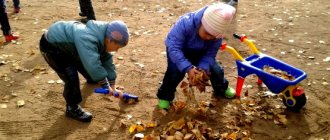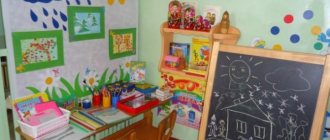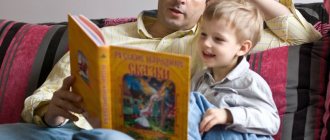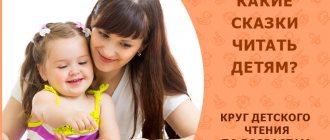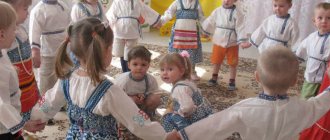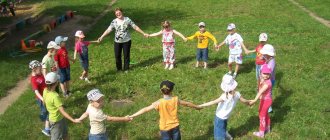Objectives of fiction in the middle group
Preschool institutions devote a special place to reading fiction. Based on the federal state standard, this activity is separated into a separate educational part. She pursues her goals and objectives. These tasks become more complex as the child grows older.
Important! New generations are required to read more than others in order to navigate the flow of information well.
Reading fiction develops thinking and speech
The main purpose of reading to children in the middle group is to develop a comprehensive personality and instill a love of reading. Its tasks are:
- development of experience in listening to works of various genres of folklore (jokes, riddles, fairy tales, etc.), prose (fairy tales and short stories), poetry (poems, fairy tales in verse);
- arousing interest in literary works, instilling a love for constant communication with books with an adult and independently;
- develop the ability to listen and perceive text. The child must understand the main meaning of the text, be able to restore cause-and-effect relationships, be able to characterize the characters of the work, and evaluate their actions;
- develop artistic and speech activity. This is achieved by retelling, expressively telling by heart jokes, poems, nursery rhymes;
- development of skills to compose poetic rhymes and descriptive stories;
- maintaining the child’s desire to express his impressions of the piece he heard. This can be done in the form of a drawing, a game of making figurines.

Children need to be instilled with a love of reading from childhood.
The objectives listed above are educational. In addition to them, there are educational and developmental tasks.
Developmental functions include:
- development of ideas about the natural world;
- speech development based on language norms;
- development of grammatical and lexical skills before the child goes to school;
- development of skills to see beauty.
Among the educational tasks the following stand out:
- formation of ideas about moral standards of behavior;
- formation of positive qualities (kindness, honesty, generosity, etc.);
- the formation of a negative attitude towards bad qualities (lies, envy, etc.).
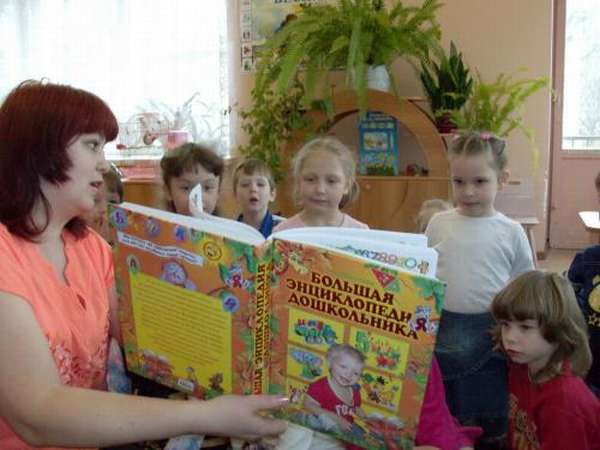
Reading serves several purposes at once
In the fourth year of life, the child’s perception of fiction is still superficial. He is able to identify only the simplest connections between ongoing events. His attention is focused on one main character and two or three minor ones. He cannot evaluate their actions without understanding the motives for their behavior.
Fiction is perceived differently in the fifth year of life. The child begins to wonder why someone did what they did and what followed. The child is already trying to establish cause-and-effect relationships.
Important! In the fifth year of life, the child begins a different stage of perception of works of art. He shows interest in them and tries to understand the deeper meaning.
Summary of a lesson on introducing middle school children to fiction. Chukovsky
A lesson on introducing children to fiction in the middle group “Visiting Grandfather Chukovsky”
Purpose: To continue to introduce children to the works of K. I. Chukovsky. Promote a full perception of works. Continue to teach children to listen carefully to excerpts from fairy tales. Introduce the fact that the same work was illustrated by different artists. Explain how important illustrations are in a book. To promote the development of interest in literary reading. Foster a love and respect for books. Dictionary: Artist - illustrator, illustrations, sheet, cover. Equipment: Portrait of K.I.
Chukovsky. Book exhibition “Favorite Fairy Tales of Grandfather Chukovsky”, it includes several fairy tales “The Fly - the Cluttering Fly”, illustrated by different artists. Exhibition of children's drawings. “Miracle Tree”, on it hang: a crocodile, a telephone, a bar of soap, a thermometer, a doctor’s cap, a teapot and saucer, a coin, a mask for the fairy tale “Confusion.” Cards with numbers 1, 2, 3, a chocolate bar, a set of children's dishes, pictures for coloring on the topic. Progress of the lesson.
The teacher removes the cloth that covers the tree and says:
Educator: Like ours at the gate, a miracle the tree grows. Miracle, miracle, miracle, miracle, wonderful. Not the leaves on it, Not the flowers on it... Who wrote these lines, Children: Korney Chukovsky.
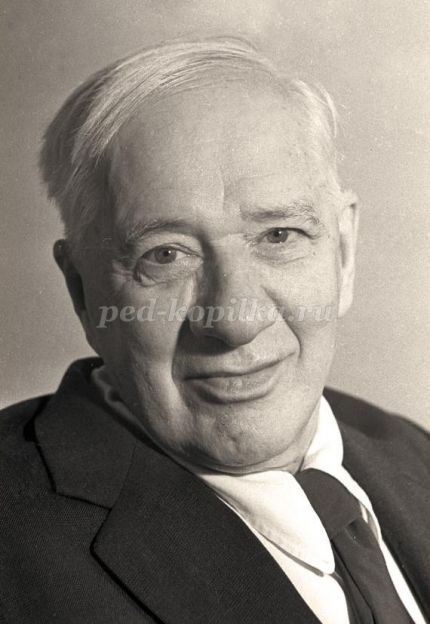
We recommend watching:
Outline of GCD for children of the middle group. Wild animals GCD outline for children of the middle group. My Homeland GCD outline for preschoolers of the middle group. Topic: Transport Summary of the GCD for children of the middle group “Geometric Kaleidoscope”
Similar articles:
Summary of lessons in kindergarten in the middle group. Profession rescuer
Summary of a lesson in kindergarten “Properties of wood.” Middle group
Lesson notes for the middle group of kindergarten
Lesson in the middle group of kindergarten. Professions of rural people
Lesson in the middle group on social and communicative development
Perception of literature in the middle group
The perception of a work of art is understood as a process that involves active activity, embodied in internal assistance, empathy for characters, and transference of events to oneself. As a result, the child feels that he is personally involved in the events taking place.
The development of perception of works goes through several stages:
- direct perception;
- empathy with the images of the work;
- the influence of literature is available.
The book arouses interest in the child at an early age. He likes to flip through pages, listen to adults read, and look at pictures. If the necessary work is carried out, then already in the third year of life the child may be interested in the fate of the heroes.
Important! The main feature of a child’s perception of a literary work is empathy for the characters.
Moral education of preschool children
Perception is an active process. The child begins to put himself in the place of the heroes, takes some mental actions and fights with enemies. Another feature of children's perception was also noted: the child does not like it when a work ends badly.
In middle preschool age, turning points occur in understanding text. This is due to the fact that life and literary experience is expanding. The child is able to establish the simplest connections in the plot. He can correctly assess the actions of the heroes. Children react to the word and show interest in it. They strive to comprehend and beat it. At this age, not only the content of the work is perceived, but also the features of the language. When the text is read, the child is able to answer questions about the text. He can think, reflect and analyze.
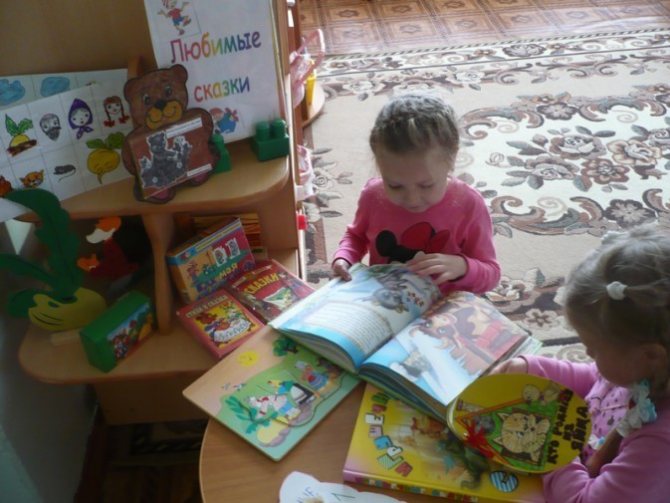
The main feature of a child’s perception of a work is empathy for the characters.
The importance of reading before bed
The importance of reading to your child before bed is as follows:
- going to bed is the best time to read. Here you need to choose the best moment when the child is ready to listen. If you make reading a daily ritual, even a restless baby will look forward to being read a bedtime story;
- the child's mood improves. Reading helps calm a child. He forgets everything that happened during the day and his mood improves. In order not to spoil it, it is better to select fairy tales that have a good ending;
- positive impact on character formation. By devoting just 20 minutes a day to reading before bed, the child becomes more obedient and attentive;
- mental abilities develop. During the reading process, the child has questions about unclear words or about the plot. In this regard, evening reading will develop his vocabulary, imagination and thinking;
- exploring the world. Thanks to fairy tales and stories, children learn what good and evil, friendship, love, hatred, selfishness are;
- the opportunity to raise a child with the help of fairy tales. The good deeds of heroes can be an example for a child;
- getting closer to the child. A connection between a child and an adult can be established through reading before bed. If a child asks to read the same book, it means he is interested in something in it.
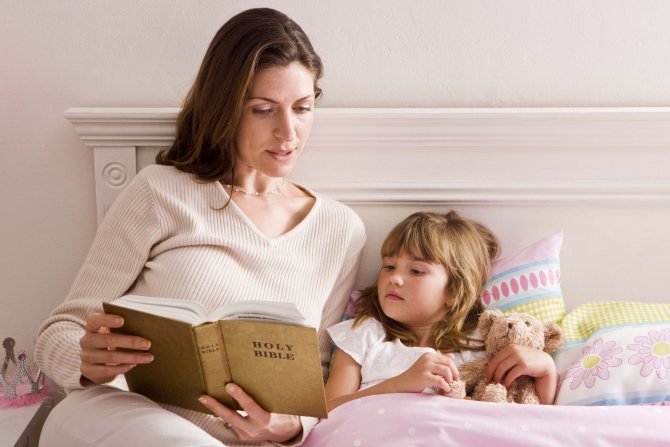
Reading before bed is a good tradition
Reading before bed should become a good tradition. With its help you can instill a love for books.
Methodology for developing and conducting CHL classes
There are various programs and notes for reading in kindergarten. Among the main methods for conducting classes in CHL are:
- The teacher reads a book or recites a story by heart. If the reader tells by heart, then he must preserve the author’s language and convey all his thoughts. A significant part of the works is read from a book;
- the teacher says something. Here the text is transmitted in free form;
- staging - secondary acquaintance with the work;
- learning by heart.
Important! Work with a book in kindergarten can be carried out in the following forms: the work is read and told, or works of oral folk art and poems are memorized.
Reading activities can be divided into several types:
- one work is read or told;
- Several works are read or narrated that have a common theme. For example, reading stories about spring. It is possible to combine works of one genre or several genres;
- works that belong to different types of art are combined into one lesson. For example, one reads a work and then looks at a painting by a famous artist that is associated with that work. It is also possible to read in combination with a piece of music. When conducting such activities, it is necessary to take into account the strength of the impact on children’s emotions. It is also necessary to take into account the responsiveness of children and their culture of behavior;
- reading is done using visual material. Such material can be: toys (for example, reading the tale of the three bears can be accompanied by a display of bear toys), a tabletop theater (it can be made of cardboard or plywood), a puppet theater, a display of filmstrips and films;
- Reading is an activity for speech development. It can be included in the content of the lesson itself, or it can be an independent lesson.
Thematic week “Indoor plants” in the preparatory group
To conduct a lesson, preparation for it is required. To do this, the following steps are carried out:
- Select a work taking into account the required criteria, taking into account the age of the children, the time of year and the method of working with the book.
- Determine the work plan. Set literary and educational goals.
- Prepare for reading. The teacher should read the work like this. So that children understand its basic meaning and idea. To do this, it is necessary to analyze the text, understand what the author was trying to convey, the character of the characters, their relationships and motives for their actions.
- Work on the expressiveness of text transmission. To do this, it is necessary to work out ways of expressing emotions (tone and intonation), correctly place stress and pauses, work on diction and correct pronunciation.
- Prepare the children. Expand their understanding of the world through excursions, studying paintings and illustrations.
MAGAZINE Preschooler.RF
Summary of a lesson on introducing children to fiction in the middle group Topic: Conversation on the fairy tale by S. Kozlov “The Winter's Tale”I, Buzulukova Valentina Leonidovna, have been working at the Medical Educational Institution “DS KV No. 16” in Usinsk since 1986.
I have a higher preschool pedagogical education. 28 years of teaching experience.
Since 2007, I have been working on the topic: “Education of moral qualities and humane feelings in children of senior preschool age through works of children’s fiction . I want to share my work experience with other colleagues on the pages of your magazine.
I am interested in reading fiction and pedagogical literature. I love to travel. I live by the principle: . ”
Dear teachers. We offer you a summary of classes on fiction in the secondary and preparatory groups. The material was prepared by a teacher of the highest qualification category Buzulukova Valentina Leonidovna.
Program content:
- Teach children to understand the figurative content of a fairy tale, answer the teacher’s questions about the content of the fairy tale using a mnemonic track. Notice and understand figurative words and expressions in the text.
- Develop children's thinking, creative imagination, and speech.
- Cultivate sympathy for fairy-tale characters in trouble.
Progress of the lesson:
1. Conversation. Children, we have guests today. Say hello to them. What is it? This letter. Who is this letter from? From the sorceress of winter. But there is something here. Look, leaves. And you will find out what we will do with them when you answer my questions. Children, what time of year is it now? Winter. How is winter different from other seasons? There is snow in winter. What kind of snow is there? White, fluffy, cold, wet. What types of snowflakes are there? Light, fluffy, patterned, small. Children, do you like winter? Yes, I like it. Tell me, what’s good when it’s winter outside? What's bad when it's winter outside? Do you know fairy tales about the winter season? Name them. (Winter hut, Little Fox and the Gray Wolf, Snow Maiden, Snow Queen, Winter's Tale).
Look at this picture, what fairy tale it is for: “A Winter's Tale” . Where was the little bear? He was sitting on a stump at the edge of the forest. I counted snowflakes and ate them. He really liked them. How many snowflakes did he eat? 300. Is this a lot or a little? (A lot of). When they flew up to the bear cub, what did they do? They stood on tiptoe. What did they say? "Hello, little bear . What did he answer? "Very nice" . Why were they enchanted? They did not melt in his stomach and remained just as fluffy. They talked to him. What happened to him? He ate a lot of snow and got sick. Who looked after Little Bear? Hedgehog. He treated Little Bear. I gave him a spruce decoction to drink, applied herbs to his stomach... Why did the hedgehog take care of the Little Bear? He was kind. And why? The bear cub was his friend. What if the hedgehog hadn’t helped Little Bear, what would have happened to him? Could someone else have helped the bear cub? (drawing up a mnemonic track).
Who did Little Bear imagine himself to be when he was sick? Snowflake. Let's turn into snowflakes and fly.
2. “Physical exercise” to music.
3. Now let's play a fairy tale. Dramatization of an excerpt from a fairy tale. What fairy tale were we talking about today?: “The Winter’s Tale” by Kozlov.
What do you think, should you help your loved ones, friends or just people who are in trouble?
4. Now take the leaves that the Sorceress - Winter sent you, and color the hero that you liked best. Show your drawings to our guests.
5. Summary of the lesson.
Children, what was your activity today? Familiarization with fiction. What did we do in class? We talked about winter. We played the game “good-bad” , named fairy tales about winter, talked about the fairy tale “Winter's Tale”, did you like the activity? - Yes. This concludes our lesson.
Summary of a lesson on introducing children to fiction in the preparatory group
Subject:
Memorizing the poem by S. Yesenin “Birch” .
Inventing the fairy tale “Snowball and Birch Tree” .
Program content:
- Teach children to memorize a poem and read it by heart expressively. Intonation conveys tenderness and admiration for the picture of winter nature.
- Foster interest and respect for nature.
- Learn to come up with a fairy tale on the theme “Snowball and Birch Tree” .
Preliminary work:
Looking at illustrations for the poem, observing winter landscapes on the street, looking at illustrations about winter.
Progress of the lesson:
1. Children, today we will have a lesson on familiarizing ourselves with fiction. We will memorize the poem by S. Yesenin “Birch” , come up with the fairy tale “Snowball and Birch” .
Look who came to us? Yes, that’s right – these are forest animals and birds. In the fall they are going to go to forest school. But they don’t know how to prepare for school. How to memorize a poem, invent fairy tales, what games to play, what tasks to complete? And they ask us to help them with this. Let's help forest readers prepare for school? Yes, we will help.
Children, what time of year is it now? - That's right - winter. What winter months do you know?
What is the weather like in winter? Yes that's right. In winter it often snows, cold winds blow, there are snowstorms, severe frosts, but there are also warm days. In winter, one day is different from the next. If there is a snowstorm, a gloomy sky, or a howling blizzard, what does the snow look like? What about the trees? They are cold and uncomfortable in winter. And when the weather is frosty, calm, sunny, what can we say about snow? What trees?
2. Physical exercise:
We are snowflakes, we are fluffs, We are not averse to spinning. We are snowflakes - ballerinas. We dance day and night.
Let's stand together in a circle - It turns out to be a snowball. We whitewashed the trees, covered the roofs with down,
They covered the earth with velvet and saved it from the cold. Children show these actions.
Many poems have been written about the beauty of winter nature.
3. Listen to S. Yesenin’s poem “Birch” .
Expressive reading of a poem.
Do you think the poet loves his native nature?
How did you guess that he loves you very much?
Have you noticed how expressively the poet speaks about snow in his poem (Border, tassels, silver, fringe).
The poem contains the following lines:
And the snowflakes burn in golden fire. What does burning mean? Expressive reading of the poem again.
How does this poem make you feel?
What voice should you use to talk about birch?
4. Reading a poem by children.
I draw the children’s attention to illustrations about winter. We look at the illustrations and determine which of these landscapes would fit the poem “Birch” .
Children, now I suggest you draw a birch tree the way you imagine it.
5. Children draw.
And now we will come up with a fairy tale on the theme: “Snowball and Birch Tree” . In a fairy tale, anything can happen: trees can talk and be friends with snow. I will try to make your fairy tale short, interesting and complete.
-Once the snow, flying past a birch tree, saw that the birch tree was standing sad and mournful. And he decided to find out what was the matter. The birch tree told him about how she gets cold in the most severe frosts and blizzards, and feels lonely without her birch tree friends. Snowball decided to help her, he called his friends - snowflakes, and they wrapped her in their warm snow. And so that she would not be so sad and lonely, they invited other birch trees to visit her.
— Once upon a time there lived a birch tree in a forest clearing. She was alone all the time, and the birch tree decided to look for friends. She thought, thought about who she should make friends with. One day it began to snow, and snowflakes began to swirl around her. They seemed to be dancing around her. The birch tree spoke to the snowflakes. And since then, the birch tree and snowflakes have been friends.
6. Summary.
Children, what did we do in class today?
| Next > |
Card index with goals for the middle group of the Federal State Educational Standard
Next, we consider reading fiction in the middle group of cards with goals for 3 months.
Month January
You can build a plan for studying fiction as follows:
- The goal of the first week is to teach children to recite poems by heart, develop imagination, speech, and develop listening skills. The theme of the week could be winter. All works must be related to winter (for example, S. Yesenin’s poem “Winter Sings, Calls...”);
- The topic of the second week: family. Goals: instilling interest in reading, developing the ability to answer questions, enriching vocabulary. Here you can read such works as: K. Chukovsky “I am my mother’s only son”, K. Ushinsky “Cockerel with his family”.
- The third week's topic is about animals. Goal: instilling a love for Russian folk tales, enriching vocabulary, developing expressive speech. This block can include such works as the fairy tale “Turnip”, D. Mamin-Sibiryak “The Tale of the Brave Hare”, solving riddles, G. Oster “A Kitten named Woof”.
Month February
The lesson plan for February is as follows:
- Theme of the first week: getting to know birds. Goals: developing the ability to empathize with characters, fostering interest in reading, developing the ability to express one’s thoughts. The works may be as follows: A. Yashin “Feed the birds in winter”, M. Gorky “Sparrow”.
- The second week is dedicated to winter nature. Goals: developing interest in fairy tales and heroes, developing imagination. Here you can read: S. Kozlov “Winter's Tale”, poems about winter, L. Voronkova “Snowing”.
- The third week is dedicated to the defenders of the Motherland. Goals: introducing children to border guards, warriors who defend the Motherland. List of works: S. A. Marshak “Border Guards”, V. Borozdin “Starships”.
Month of March
March classes include the following:
- First week: March 8 - Women's Day. Goals: getting to know new poems, memorizing them, developing memory, nurturing love and respect for mother, broadening one’s horizons about spring. Works: V. Shugraev “To Mom”, E. Blaginina “Mom is sleeping, she is tired.”
- Second week: necessary items. Goals: introducing children to new works, developing auditory attention, developing the ability to answer questions. Works: A. Matutis “Look What a House”, A. Barto “The Lame Stool”.
- Third week: space. Goals: expanding children's ideas about space. Reading various stories about space, a fairy tale about the solar system by M. Hrdazhe.
Important ! In the autumn months it is worth devoting classes to studying autumn, in the summer - summer. Other relevant topics will be the study of professions, the process of sleep, and birth.
Fiction plays a huge role in the development of a child. It is important to instill a love of reading from early childhood.
Card file “Literature for home reading on lexical topics”
Card index
“Literature for home reading on lexical topics”
Compiled by: Gorbovskaya I.M.,
teacher-defectologist MBDOU "Kindergarten No. 5"
Usolye-Sibirskoye, Irkutsk region
| № p/p | Lexical topic | Fiction |
| 1. | "Autumn" |
|
| 2. | "Garden. Vegetables" |
|
| 3. | “My kindergarten. My group" |
|
| 4. | "My family" |
|
| 5. | "Mushrooms, forest berries of the Baikal region" |
|
| 6. | "Lake Baikal" |
|
| 7. | "Pets and their young" |
(translated by S. Mikhalkov). |
| 8. | "Poultry and Chicks" |
|
| 9. | "Dishes" |
|
| 10. | "Children's rights" |
“Geese - Swans”, “Sister Alyonushka and Brother Ivanushka” (arranged by A. N. Tolstoy) |
| 11. | "Professions" |
|
| 12. | "My city, my home" |
|
| 13. | "Winter. Wintering birds" |
|
| 14. | "Wild Animals in Spring" |
|
| 15. | "New Year" |
|
| 16. | "My health" |
|
| 17. | "Cloth. Hats" |
|
| 18. | "Shoes" |
|
| 19. | "Transport" |
|
| 20. | “February 23 – Defender of the Fatherland Day” |
|
| 21. | "Furniture" |
|
| 22. | “March 8 – International Women’s Day” |
|
| 23. | "Houseplants" |
|
| 24. | "Spring is approaching us..." |
|
| 25. | "The world of the book. Creativity of S. Marshak" |
|
| 26. | "My country" |
|

Books are ships of thought, traveling the waves of time and carefully carrying their precious cargo from generation to generation.
Francis Bacon
6


